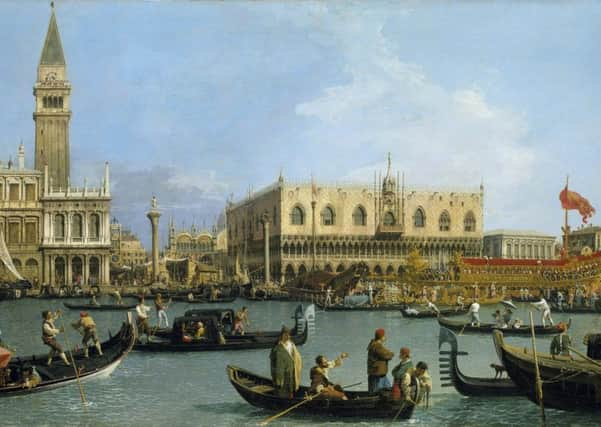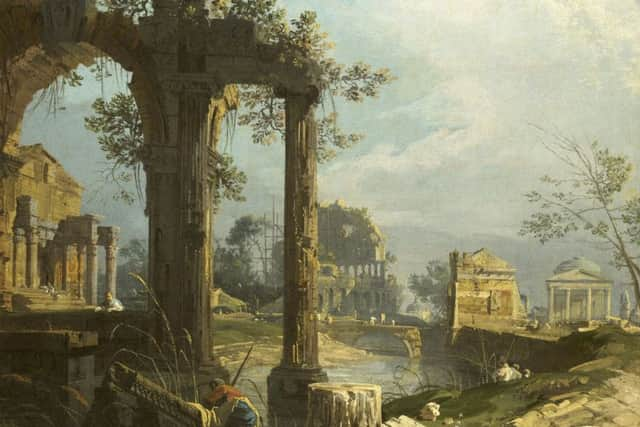Art review: Canaletto & the Art of Venice, Queen's Gallery, Edinburgh


Art review: Canaletto & the Art of Venice, Queen’s Gallery, Edinburgh ****
Canaletto is a universal favourite. He apparently paints what he sees and what he sees is mostly the beauties of Venice. He was by no means the whole story of Venetian art in the 18th century however, nor indeed of Smith’s collection. Other painters represented here include Sebastiano and Marco Ricci, Franceso Zuccarelli and Pietro Longhi. Venice in the 18th century is usually represented as a city in irreversible decline, its art faded from its former glory. It follows that when Napoleon ended the Venetian Republic, it was really an act of mercy; it was dying anyway. In the handsome publication that accompanies this exhibition, its curator, Lucy Whitaker, rejects this view and describes how in fact Venice enjoyed a period of renewed prosperity in the 18th century. When the rest of Europe was constantly at war, Venice enjoyed peace. Nor had the brilliance of its art faded. Its artists were in demand throughout Europe. Tiepolo worked in Germany and at the Spanish court in Madrid. Sebastiano and Marco Ricci, Zucarrelli and Canaletto all worked in England for periods of years. Consul Smith was an important part of this fruitful connection.
Advertisement
Hide AdSmith’s collection was not comprehensive however. It reflected his friendships and so, for instance, though uniquely rich in the work of Canaletto, it has nothing by his younger rival, Francesco Guardi. Even Tiepolo, the most celebrated of Venice’s 18th-century painters, is represented here only by etchings which are nevertheless brilliant. Smith did buy one work from him, but had parted with it before he sold his collection to the king.


Sebastiano Ricci, born in 1659, nearly 40 years before Canaletto, is the senior painter here. His Adoration of the Shepherds, a sketch for an altarpiece, is a beautiful and luminous work. Lit from above by a glory of angels, it plainly recalls the artist’s inheritance from Titian and Veronese and in its lively execution it anticipates Tiepolo. Another picture, The Finding of Moses, explicitly quotes Veronese. But if they are not highly original, these pictures are certainly highly accomplished. The great skill and sensibility that underlies them is illustrated by a selection of his drawings, especially an exquisite pastel study of two female heads.
Sebastiano’s nephew, Marco, was best known as a landscape painter, though of imaginative landscapes like the lovely Landscape with a Woman and Child in the Foreground here, rather than of views like Canaletto. Zucarrelli was master of the same style of landscape. Both painters drew on the example of Claude and Poussin to create what was seen at the time as “classical” landscape painting. Zucarrelli’s River Landscape with Apollo and Daphne and Landscape with Diana Visiting Endymion are beautiful examples of this genre.
The Married Couple’s Breakfast and Blind Man’s Buff by Longhi are a pair of charming pictures full of delicate innuendo on the theme of love. The married couple, if indeed that’s what they are, are having breakfast in bed after what was evidently an amorous night. A male and a female servant who have brought their breakfast are whispering together and seem inclined to follow their example. A painting on the wall of Adonis leaving Venus implies, however, that love will not last. In the pendant picture, the pretty and fashionable people playing Blind Man’s Buff provide a matching riff on the blindness of love.
Consul Smith ran a publishing house and there are also examples of his publications as well as of prints from his collection. These include the work of John Baptist Jackson, who revived the Renaissance technique of chiaroscuro woodblock printing. He also published etchings by his friend Canaletto. The two men met in 1723. Canaletto was born in 1697 so was still a young man and the group of his works here begins with paintings from those first years, like the Piazza San Marco looking west towards San Geminiano. It has a directness which his later work to some extent loses. The left side is in strong shadow. Figures going about their business move in and out of the light. Across the piazza, there is a temporary theatre draped in curtains and you feel that it is the theatre of daily life that most intrigues Canaletto, not the magnificent stage in which it is set. Within a couple years, his style has become more summary. You can see the rapidity of his brushstrokes as he works directly, drawing with his brush though always over a carefully constructed architectural setting. People and the animation of the scene continue to fascinate him, however, even as he gets more economical in the way he treats them. In the Bacino di San Marco on Ascension Day, the Bacino, the Doge’s magnificent golden barge which is the ostensible subject, is set well back. Our attention instead is drawn to a near collision of three gondolas and what seems to be a “trajetto,” one of the little ferries which cross the Grand Canal, picking its way through the scrum, then as now its passengers standing stoically upright.
As well as this human animation, it is Canaletto’s superb observation of light that makes these pictures come to life. This is true both in the overall effect and in the detail. In the same picture, for instance, there is a couple in a gondola under a parasol, its shadow as delicately observed as by any Impressionist. A Regatta on the Grand Canal is a similar painting of spectacle with people in carnival costume and wonderfully decorated boats. An enigmatic figure on the left who, alone in the picture, is looking directly at us, might be Smith himself, but we cannot be sure. For all his vanity and patronage, he left no certain portrait of himself.
Advertisement
Hide AdThe scale of Smith’s patronage of Canaletto is most clearly evident in a set of 12 paintings of the Grand Canal. As the canal is more than a mile long these pictures, recording both sides, cover two and a quarter miles of intricate architecture. All this was based on drawing and Canaletto’s drawings are a delight. At times he cheerfully used a ruler to get his perspective right, but he was also capable of capturing the light on water and misty distances with nothing more than pen and ink with the lightest touches of wash. In his lifetime he was looked down on as a mere view painter. He was not elected to the Venetian Academy of Fine Arts till late in life. He has had the last laugh. He is undoubtedly one of the great stars of Venetian art.
Until 21 October